This short lesson is about a type of chord that occurs frequently in Steely Dan songs and that is known to Steely Dan fans as the ‘mu major chord’ or the ‘µ chord‘.
Mu major is another name for an add 2 chord and is nothing more than a major triad with an added 2:
Mu chord formula: 1 2 3 5
(This type of chord is not the same as a sus2 chord because sus2 chords do not contain a 3rd.)
The add 2 chord is not invented by Steely Dan and many artists (notably Herbie Hancock and Roy Ayers) have been using this chord long before them. The manner and frequency Steely Dan has been using the chord in their music made the mu major chord a part of Steely Dan’s signature sound.
The name ‘Mu major’ itself started as a joke, the exact reasons for calling it that way are forgotten.
The main sound characteristic of the chord is the major 2 interval between the 2 and the 3. This interval has to be present because it is the essence of this chord’s appeal (Donald Fagen’s own words).
To hear the Mu major chord in action, listen to songs like Reelin in the Years (the intro) from the album Can’t Buy a Thrill or Deacon Blues (also the intro) and Aja from the album Aja.
The mu major chord is usually played on the piano in Steely Dan albums, but also on the guitar. These chords are much harder to play on the guitar than on the piano though.
In the words of Walter Becker:
“That’s something that I did where available on guitar. It’s always available on piano. We had Denny (Dias) do it on the guitar because he had far greater dexterity. But whole-tone dissonances like that are quite awkward on guitar except in certain open chord positions”.
Mu Major Guitar Chord Voicings
A mu major with an open bass note:
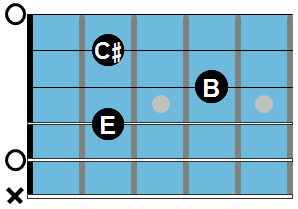
A mu major with the bass note on the 6th string:
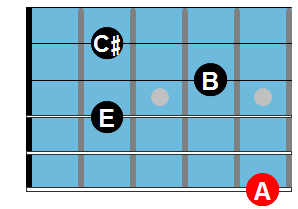
Another voicing for A mu major:
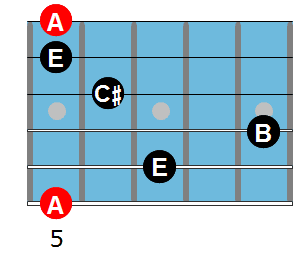
D mu major with an open bass note:
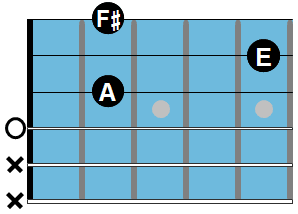
The same D mu major, but with the bass note on the 5th string:
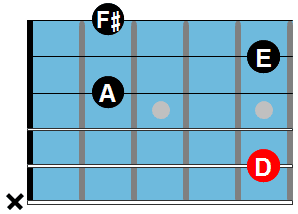
E mu major with an open bass note:
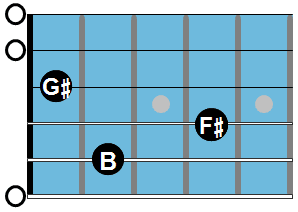


Another way to describe this chord is “drop 9, no 7th” based on “dropping” a chord tone down an octave from its normal position in a chord stack (1-3-5-7-9-11). In arranging or piano voicing, you might create various “open” voicings by dropping one or more chord members. Ex. “C Maj 7 drop 3, drop 7 would create a common piano voicing (from bottom up): E – B – C – G. Just another helpful way of thinking about voicings, instead of always low-to-high.
I also always thought of this as an Aadd9 chord. David Gates from Bread fingers an open string version in song like “If” – eg
E-0
B-0
G-6
D-7
A-0
E-x
Also Dadd9 can be played open.
Chord name is add9,triad + 2(9).
Thanks Marty, for that Gmu. Knew a fair amount of them but not that. What a marvelous sound.
I like this rootless G mu major x2523x – works well in the Peg verse Cmaj7 (x3545x) to G mu
marvellous,thanks for that inversion
If you play this chord with an open low e and the F# on the high e string it gives you a nice Em9(11)
I always call this voicing the “Doctor Slump” voicing, because it litteraly is Steve Khan’s Dr Slump. Guess it’s no wonder he was SD’s Gaucho’s guitar man.
Forgot to mention — it is indeed “Dr Slump” if you play the D# on the high e, for a nice Major7add9 sound (0-11-14-11-12-11) !
I certainly agree with the statement that this type of chord is always available on piano. On guitar, it takes a high level of skill (and as mentioned above, dexterity) to utilize. On piano, I like this type of chording, gives a nice, full sound- particularly when playing solo. Thanks for posting!
Nicole
Resonator Blog Store
Also works great with 7th chords, minor chords.
I learned this as an “add 9” chord – a major (or minor) triad with the 9th/2nd added, and no 7th. A couple of easy fingerings I use (not necessarily with the root in bass):
G chord
E- 5
B- 3
G- 4
D- 5
or
E- 3
B- 3
G- 4
D- 7
or a D chord
E- 2
B- 3
G- 2
D- 2
Wouldn’t this fingering also work? (A mu major): 6th string 5th fret, 5th string 4th fret, 3rd string 4th fret, and 2nd string 5th fret (and if dexterous enough, 1 string open to get extra E ring). Seems easier to me, less stretching.
Pls add the correct finger positions to make it easier.
also if you needed a chord for E mu major an easy enough “shape” that meets this criteria is
e 2
B 5
G 4
D 6
A x
E x
Easy enough if you have long fingers, otherwise will take some stretching and straining for a while.
I think it’ll be easier to play the chords if the correct finger positions are added.